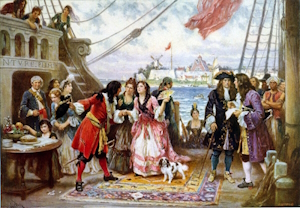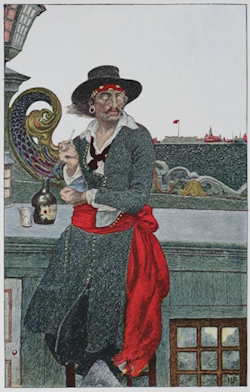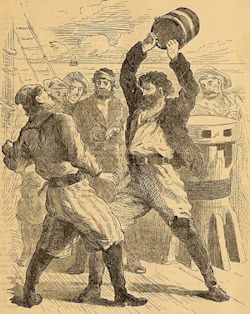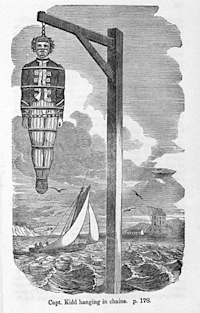 William Kidd, better known as Captain Kidd, had a very unfortunate career. He is believed to have been born into a poor seaman’s family in Dundee, Scotland in around 1654, later settling in New York. Not much else is known about his early life except that he took to the seas like his father before him. Although active in the grey area of privateering, it is likely that he never intended to adopt a life of piracy and was simply a victim of circumstances.
William Kidd, better known as Captain Kidd, had a very unfortunate career. He is believed to have been born into a poor seaman’s family in Dundee, Scotland in around 1654, later settling in New York. Not much else is known about his early life except that he took to the seas like his father before him. Although active in the grey area of privateering, it is likely that he never intended to adopt a life of piracy and was simply a victim of circumstances.
Kidd the privateer
Kidd is thought to have worked on a French privateer frigate, the Sainte Rose, during peace time. He was involved in actions against the Dutch and Spanish, including participating in the failed French attack on the Dutch Guianas. When England declared war on France in 1688, Kidd patriotically became a privateer against the French in American theatre of the War of the Grand Alliance known as King William’s War. He seized the French vessel, a twenty-gun brig, which he was serving aboard, while it was anchored off St. Kitts, which the French had attacked. He and the English members of the crew absconded with the ship, sailing her to Nevis, an English occupied island. The ship was rechristened the Blessed William and Kidd became her captain. He and his men participated in various attacks on French settlements and vessels from which he greatly profited, also helping to defend Nevis from French attack. Although Kidd did well out of it, his men were deprived of prize money and grew tired of their Kidd’s dictatorial methods. They mutinied when Kidd was ashore, and under Robert Culliford stole the vessel and prize money, turning pirate and sailing for New York. Kidd was given a 16-gun sloop, the Antigua, to hunt down the mutineers, who were still believed to be in New York, but they had already left by the time he arrived. While in New york Kidd helped to put down the Leisler’s Rebellion, which broke out while he was there. He then settled down in the city, marrying the wealthy widow Sarah Bradley Cox. While there he received a commission from the governor to defend American shores from French incursions.
Kidd the pirate hunter
 Kidd returned to England in 1695 where he unsuccessfully attempted to obtain a commission in the Royal Navy. He was urged by Richard Coote, Earl of Bellomont, and four other high status backers to become a pirate hunter. He received a commission to hunt pirates such as Thomas Tew in the Indian Ocean from King William, as well as being given the 287-ton oared frigate Adventure Galley, which was armed with 32 guns. It had 46 sweeps to enable versatility in calm waters and a crew of about 150 men, who were to receive a share of plunder instead of regular pay. The aim of the enterprise was to make a profit for his backers. He was apparently so confident of success that he signed a bond for £20,000 making him liable if there was no return on the expedition. The Adventure Galley left London in April 1696. He lost many of his original crew after insulting a King’s ship by not saluting it while sailing down the Thames. The crew allegedly exposed their backsides when challenged, resulting in 30 of the most experienced sailors being seized and pressed into the service of the Royal Navy. Short-handed and with some difficulty, he found replacements in New York, many of whom were said to be smugglers, former pirates, and other rogues.
Kidd returned to England in 1695 where he unsuccessfully attempted to obtain a commission in the Royal Navy. He was urged by Richard Coote, Earl of Bellomont, and four other high status backers to become a pirate hunter. He received a commission to hunt pirates such as Thomas Tew in the Indian Ocean from King William, as well as being given the 287-ton oared frigate Adventure Galley, which was armed with 32 guns. It had 46 sweeps to enable versatility in calm waters and a crew of about 150 men, who were to receive a share of plunder instead of regular pay. The aim of the enterprise was to make a profit for his backers. He was apparently so confident of success that he signed a bond for £20,000 making him liable if there was no return on the expedition. The Adventure Galley left London in April 1696. He lost many of his original crew after insulting a King’s ship by not saluting it while sailing down the Thames. The crew allegedly exposed their backsides when challenged, resulting in 30 of the most experienced sailors being seized and pressed into the service of the Royal Navy. Short-handed and with some difficulty, he found replacements in New York, many of whom were said to be smugglers, former pirates, and other rogues.
A spate of bad luck
 With a full crew Kidd sailed to Madagascar, but found the pirates had already departed. They also found no French ships and time was running out for Kidd. He stopped for careening and repairs, but lost many men to disease, possibly cholera. On sailing to the Red Sea, he attacked a convoy but was driven off by its armed escorts. The crew became increasingly mutinous, especially when water started running low. In August, Kidd stopped an English ship, the Mary, and the crew plundered it unknown to Kidd while its captain, Thomas Parker, was in Kidd’s cabin. He ordered his men to return the stolen property, which they reluctantly did. The expedition was continually plagued by desertions, disease, and storms. Additionally, the lack of plunder made the crew ever more mutinous. They took some small prizes, but when Kidd refused to attack Dutch ship, not deeming it a legitimate target, the situation really came to a head. On 10th October 1697, Kidd, who was known to have a temper, killed one of the rebellious crew members, gunner William Moor, with a bucket after the man had blamed him for their dismal predicament and accusing him of cowardice, causing even more tension on board the ship. He lost the respect of crew who wanted to turn pirate to better their conditions.
With a full crew Kidd sailed to Madagascar, but found the pirates had already departed. They also found no French ships and time was running out for Kidd. He stopped for careening and repairs, but lost many men to disease, possibly cholera. On sailing to the Red Sea, he attacked a convoy but was driven off by its armed escorts. The crew became increasingly mutinous, especially when water started running low. In August, Kidd stopped an English ship, the Mary, and the crew plundered it unknown to Kidd while its captain, Thomas Parker, was in Kidd’s cabin. He ordered his men to return the stolen property, which they reluctantly did. The expedition was continually plagued by desertions, disease, and storms. Additionally, the lack of plunder made the crew ever more mutinous. They took some small prizes, but when Kidd refused to attack Dutch ship, not deeming it a legitimate target, the situation really came to a head. On 10th October 1697, Kidd, who was known to have a temper, killed one of the rebellious crew members, gunner William Moor, with a bucket after the man had blamed him for their dismal predicament and accusing him of cowardice, causing even more tension on board the ship. He lost the respect of crew who wanted to turn pirate to better their conditions.
Kidd the pirate
In November 1697, Kidd and his crew captured a French ship, which although a legitimate target carried little of value. Off the coast of Indian in January 1698, Kidd refused to take a 400-ton Indian ship, Quedagh Merchant, captained by the Englishman Captain Wright, which was transporting some Armenian merchants and their rich cargo of, among other things, satin and gold. The crew forced him to seize it, officially making them all pirates. As the ship had a French pass Kidd convinced himself it was a legal target. He renamed it the Adventure Prize and sailed to Madagascar in it, where he met the pirate Robert Culliford and his ship Mocha Frigate on Saint Mary’s Island. It is reported that Kidd ordered his crew to attack the pirate vessel – their mission was, after all, to hunt pirates, but the crew declined to do this. Many chose to join Culliford, leaving only about 15 men remaining loyal. Kidd burnt the Adventure Galley as it was poorly built and was now leaking badly, after which he returned to the Caribbean on Adventure Prize in 1699, stopping first at St. Augustine’s Bay, Madagascar for repairs, where he probably became aware that a price had been put on his head. He sold most of the goods and hid his ship somewhere near Hispaniola. He is said to have buried some of his treasure on Gardiner’s Island, off the coast of New York, which he planned to fetch when the heat had died down or to use as a bargaining tool.
Kidd’s arrest and Trial
 The act of seizing one of the Moghul’s ship caused tensions between the East India Company and the Indian rulers, as a result of which a price was put on Kidd’s head. Kidd’s actions also caused a political scandal back in London. He had aroused such a furore that when in 1698 William III announced the Act of Grace pardoning all pirate’s, Kidd along with Henry Avery was exempted from it. Despite this, Kidd proclaimed he was innocent of piracy. He bought an unrecognisable sloop after abandoning the Quedagh Merchant and returned to New York, where he probably expected support and clemency. Governor Bellomont, one of the investors, fearing being implicated in the scheme lured Kidd to Boston and had him arrested there. After a failed escape attempt, he was imprisoned in solitary confinement for a year before being sent back to England where he was incarcerated in Newgate Prison to await trial, suffering greatly while he was there. The trial began on 8th May 1701 along with nine others, who were all later acquitted. He was charged with piracy and the murder of William Moor, pleading not guilty to both counts, relying on the French passes he had taken to prove his innocence – they never turned up. He refused to give the names of his co-conspirators, hoping his loyalty would be rewarded, but his backers distanced themselves from him and made him a scapegoat. After a trial without adequate counsel and in which the odds were stacked against him, Kidd was found guilty on both charges and was sentenced to death. He was hanged at Execution dock in Wapping on 23rd May 1701 in front of a huge crowd. The rope snapped on the first attempt, the crowd regarding it as providence, a sign of his innocence, but to no avail – the second attempt was successful. His body was hung in a gibbet at Tilbury Point for all to see. A song, The Ballad of Captain Kidd, was written not long after his execution and became very popular.
The act of seizing one of the Moghul’s ship caused tensions between the East India Company and the Indian rulers, as a result of which a price was put on Kidd’s head. Kidd’s actions also caused a political scandal back in London. He had aroused such a furore that when in 1698 William III announced the Act of Grace pardoning all pirate’s, Kidd along with Henry Avery was exempted from it. Despite this, Kidd proclaimed he was innocent of piracy. He bought an unrecognisable sloop after abandoning the Quedagh Merchant and returned to New York, where he probably expected support and clemency. Governor Bellomont, one of the investors, fearing being implicated in the scheme lured Kidd to Boston and had him arrested there. After a failed escape attempt, he was imprisoned in solitary confinement for a year before being sent back to England where he was incarcerated in Newgate Prison to await trial, suffering greatly while he was there. The trial began on 8th May 1701 along with nine others, who were all later acquitted. He was charged with piracy and the murder of William Moor, pleading not guilty to both counts, relying on the French passes he had taken to prove his innocence – they never turned up. He refused to give the names of his co-conspirators, hoping his loyalty would be rewarded, but his backers distanced themselves from him and made him a scapegoat. After a trial without adequate counsel and in which the odds were stacked against him, Kidd was found guilty on both charges and was sentenced to death. He was hanged at Execution dock in Wapping on 23rd May 1701 in front of a huge crowd. The rope snapped on the first attempt, the crowd regarding it as providence, a sign of his innocence, but to no avail – the second attempt was successful. His body was hung in a gibbet at Tilbury Point for all to see. A song, The Ballad of Captain Kidd, was written not long after his execution and became very popular.
The story of Captain Kidd was much romanticized after his death and his exploits became a popular subject of pirate-themed works of fiction. The loot he had deposited on Gardiner’s Island was recovered by the authorities, but many believed in the existence of more buried treasure, an idea popularized by the broadside song written about him after his death, but despite several treasure hunts over the years none was ever found. In 1911, Ralph D. Paine, an American Journalist who wrote the book The Book of Buried Treasure, discovered the French passes which might have saved him. They had been misfiled in the Public Records Office in London. The wreckage of the Adventure Prize was found in 2007 off the Dominican Republic.
For more details about William Kidd’s unfortunate career read the article Captain William Kidd by Cindy Vallar on her Pirates and Privateers website.
